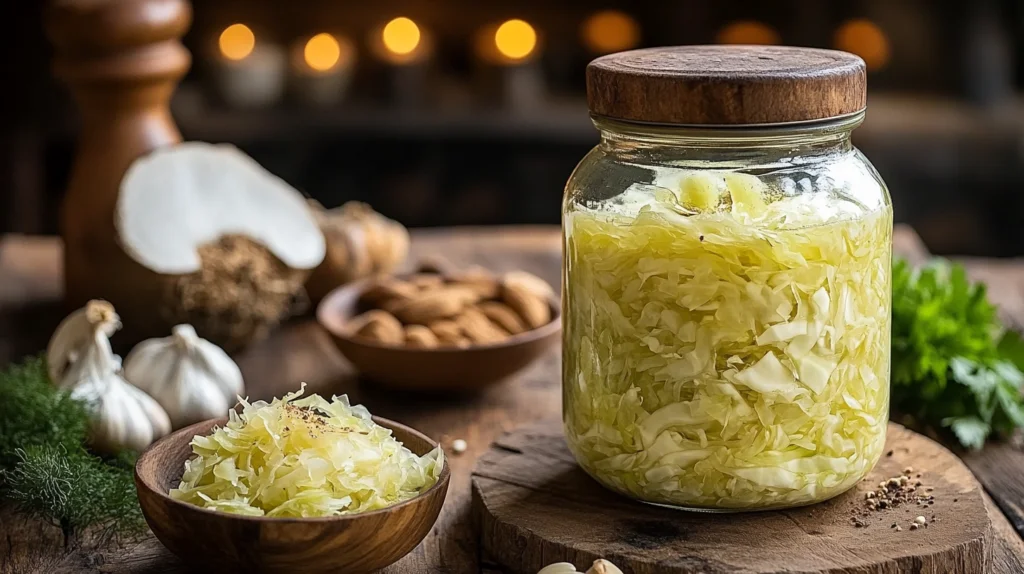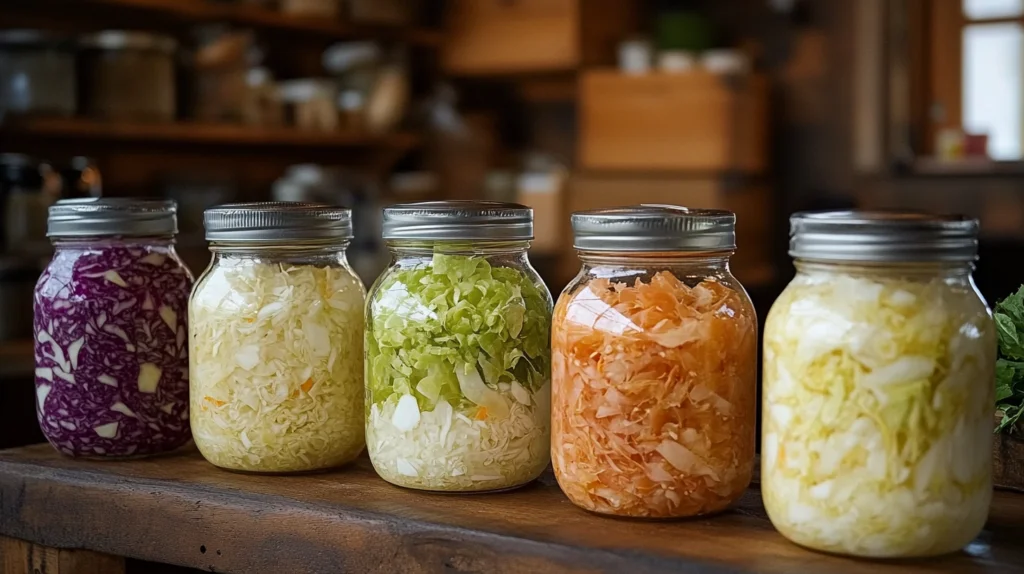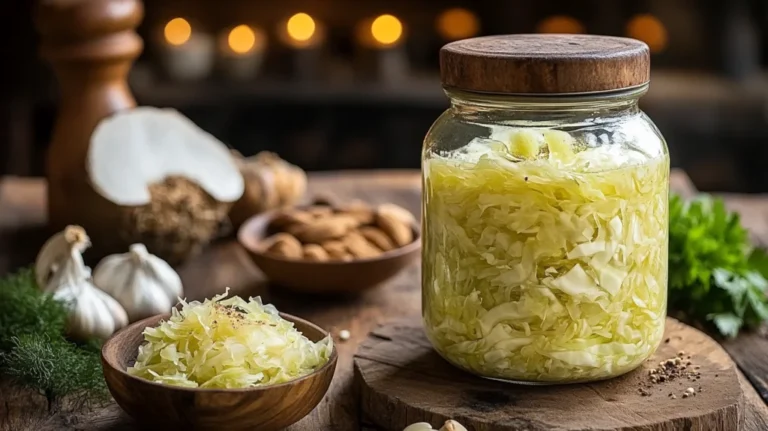
Introduction
Brief History of Coal Miners’ Sauerkraut Recipe
You might wonder how such a humble dish as sauerkraut became a staple in the diet of coal miners. Surprisingly, its roots are steeped in tradition and practicality. Historically, coal miners faced grueling work conditions and needed food that was not only filling but also nutritious and shelf-stable.
In the early days of mining, particularly in regions like Pennsylvania and West Virginia, families would often prepare sauerkraut at home. This preservation method allowed them to enjoy the benefits of cabbage throughout the harsh winters when fresh vegetables were scarce.
The perfect balance of tangy and crunchy. This sauerkraut recipe brings a traditional flavor with a probiotic twist. It’s a crowd-pleaser every time! Sarah M., recipe tester and sauerkraut enthusiast
The simplicity of the Coal Miner’s recipe for sauerkraut meant that it required very few ingredients, but it packed a punch in terms of flavor and health benefits. Many miners learned the craft of fermenting cabbage from their ancestors, making sauerkraut not only a nutritional choice but also a cultural practice that connected them to their roots.
Significance of Sauerkraut in Coal Miner’s Diet
Sauerkraut was not just a side dish; it played a vital role in the daily diet of coal miners for various reasons:
- Nutrient-Dense: Packed with vitamins C and K, this fermented dish helped strengthen miners’ immune systems, which was crucial given the physical demands of their jobs.
- High in Fiber: The fiber content promoted digestive health, an essential factor for those consuming a diet rich in starches and meats and often lacking in fresh produce.
- Probiotic Benefits: Fermentation adds beneficial bacteria that enhance gut health, which is particularly important for individuals with labor-intensive jobs, where maintaining energy and health is paramount.
From my own experience, I remember sitting around the dinner table, where my grandmother would serve her homemade sauerkraut alongside hearty meats and potatoes. It transformed our meals, providing a tangy contrast that balanced the richness of the other dishes. Many miners likely shared similar experiences, having their nourishment tied to the comfort and flavors of home.
In essence, sauerkraut has become more than just a food item; it’s a symbol of resilience and resourcefulness that echoes through the history of coal miners. Understanding its background helps us appreciate every bite we take today.
Ingredients Used in Coal Miner’s Sauerkraut Recipe
As we delve deeper into the world of coal miners’ sauerkraut, it’s essential to spotlight the ingredients that make this traditional dish a cornerstone of their diet. Each component plays a crucial role in flavor, preservation, and nutritional value. Let’s break down the primary ingredients of this beloved recipe.

Cabbage
The star of the show is undoubtedly cabbage! This leafy green vegetable is the foundation of sauerkraut, providing both substance and health benefits.
- Varieties: While green cabbage is most commonly used, I often like experimenting with savoy cabbage for a slightly softer texture.
- Nutritional Benefits: Cabbage is rich in vitamins C and K, fiber, and antioxidants. It supports overall health and plays an integral role in the fermentation process.
Growing up, I remember the excitement of heading to the local farmer’s market, where fresh, crisp cabbages awaited. There’s something satisfying about knowing the source of your food, and that’s precisely what coal miners valued during their tough daily routines.
Salt
While we often think of salt merely as a flavor enhancer, its role in sauerkraut is so much deeper. Salt is essential for:
- Fermentation: It draws out moisture from the cabbage, creating a brine that facilitates the natural fermentation process.
- Preservation: Salt helps keep the sauerkraut safe from unwanted bacteria, allowing it to last long periods—perfect for miners who needed food that wouldn’t spoil quickly.
I fondly recall my grandmother emphasizing the importance of the right salt amount to achieve the ideal crunch and flavor. Too little, and the cabbage would be mushy; too much, and it would be too salty. It’s all about balance!
Caraway Seeds
To add a unique flavor twist, many coal miners incorporated caraway seeds into their sauerkraut.
- Distinctive Flavor: Caraway seeds introduce a warm, slightly sweet, and nutty flavor profile that elevates the dish.
- Health Benefits: These seeds are known for their digestive benefits, helping to ease bloating and improve gut health.
I added some caraway seeds, and wow—this recipe has become a staple in my kitchen. It’s a wonderful way to bring a bit of old-world flavor to modern meals! Laura K., foodie and recipe experimenter
Their aroma always reminded me of childhood baking days, bringing warmth and comfort to the kitchen. Knowing that coal miners enjoyed this culinary touch in their meals felt like connecting to a larger community of food lovers.
In summary, each of these ingredients adds depth, flavor, and nourishment to the coal miner’s sauerkraut recipe, creating a dish that is both significant and satisfying.
Preparation Process of Coal Miner’s Sauerkraut
Now that we’ve explored the essential ingredients of the coal miner’s sauerkraut, let’s dive into the preparation process. It may seem simple, but the art of making sauerkraut is rooted in technique and care.

I never realized how simple making sauerkraut at home could be. The fermentation process is easy, and the result is a flavorful, healthy addition to every meal. James P., home cook and fermenting newbie
Shredding the Cabbage
To start, you’ll want to prepare your cabbage—this step is where the journey begins! Shredding cabbage can be a meditative experience, and it’s surprisingly satisfying.
- Choosing the Right Tool: A sharp knife or a mandoline is key to achieving that perfect, uniform shred. When I help my kids in the kitchen, we love using a simple box grater; it’s a bit messy, but they enjoy the process!
- Desired Texture: Aim for thin slices, roughly 1/4 to 1/2 inch wide. This ensures even fermentation and best flavor release.
- Quantity: Typically, around 5-7 pounds of fresh cabbage is ideal for a large batch. My grandmother would always say, “More cabbage means more memories!” as she filled her bowl to the brim.
Once shredded, don’t rush to the next step. Take a moment to admire that vibrant pile of green—it’s a sign of flavorful sauerkraut to come!
Salting and Fermenting
With your cabbage neatly shredded, it’s time for the magic to happen through salting and fermenting. This is truly where the transformation takes place.
- Salting the Cabbage: For every pound of cabbage, you’ll need about 1 to 1.5 tablespoons of salt. Sprinkle it evenly over the shredded cabbage. As you mix, make sure to massage the salt into the cabbage, which helps release its natural juices.
- Creating the Brine: This process creates a brine that will cover the cabbage during fermentation. You’ll know you’ve done it right when the cabbage feels slightly wilted and begins to float in its own juices.
- Pack it Tight: Once your cabbage is perfectly salted, pack it tightly into a clean fermentation vessel (a large glass jar or ceramic crock). This is essential; you want the cabbage submerged in the brine to prevent any unwanted mold.
- Waiting Game: Now comes the hardest part—patience! Cover the jar with a cloth and let it sit in a cool, dark place for about 2 to 4 weeks. During this time, the beneficial bacteria will work their magic, turning your cabbage into tangy sauerkraut.
I still remember the thrill of checking my grandmother’s jars almost daily, inhaling the tangy aroma of fermentation. Each bubbling sound was a little reminder of the deliciousness to come. This preparation process is a beautiful homage to both tradition and the simple joys of food.
Variations of Coal Miner’s Sauerkraut Recipe
As we celebrate the time-honored coal miner’s sauerkraut recipe, it’s exciting to explore how various twists can enhance this classic dish. While the original recipe holds deep cultural significance, there are delightful variations worth considering that can bring unique flavors and appeal to diverse palettes.
Adding Juniper Berries
One popular variation that has recently captured my interest is the addition of juniper berries. These little berries pack a powerful punch of flavor!
- Distinctive Flavor Profile: Juniper berries lend a slightly sweet, piney taste that complements the tanginess of sauerkraut beautifully. When I first tried this, I was amazed at how it took the traditional flavor to new heights.
- Health Benefits: Besides their aromatic qualities, juniper berries are believed to aid digestion and have anti-inflammatory properties. Hence, not only are you enhancing flavor, but you’re also getting added health benefits!
- Incorporation: To add juniper berries to your sauerkraut, simply toss in a handful (around 1-2 tablespoons) along with the shredded cabbage during the salting process. If you’ve never cooked with them before, a little goes a long way, so start small.
This variation has become a family favorite at gatherings. Everyone can’t help but comment on the delightful and unexpected flavor that makes the sauerkraut memorable!
Using Red Cabbage
Another creative twist on the classic recipe is to swap out green cabbage for red cabbage. This variation not only looks stunning but also offers a unique flavor and nutrient profile.
- Color and Presentation: Red cabbage brings a vibrant color that immediately catches the eye. I recall bringing a jar of bright red sauerkraut to a potluck, and it was a hit—a feast for both the eyes and the palate!
- Flavor Differences: Red cabbage tends to have a sweeter and milder flavor compared to its green counterpart. This can make it more appealing to those who may find sour flavors overwhelming.
- Health Boost: Red cabbage is rich in antioxidants and anthocyanins, compounds that provide numerous health benefits, including improved heart health.
When making sauerkraut with red cabbage, use the same process and measurements as with green cabbage. The result? A beautiful, nutrient-rich dish that tells a story of innovation and tradition merging seamlessly.
Exploring these variations not only breathes new life into a cherished recipe but also allows us to appreciate the resourcefulness and creativity of coal miners’ culinary traditions. Each bite tells a story, connecting us to a rich history while embracing the evolving world of flavors!
Benefits of Sauerkraut in Coal Miner’s Diet
Having explored the variations of the coal miner’s sauerkraut, it’s essential to highlight the significant benefits this fermented food brings to the table—especially for the hardworking miners who relied on it. The nutritional value and digestive aid properties of sauerkraut contribute to its longstanding place in their diets.
Nutritional Value
First and foremost, the nutritional bounty of sauerkraut is impressive! Here’s what makes it a powerhouse:
- Rich in Vitamins: Sauerkraut is particularly high in vitamin C and K. Vitamin C is crucial for immune function, which was especially important for miners exposed to harsh conditions and potential illnesses. Vitamin K supports bone health, a benefit nobody could afford to overlook in physically demanding work environments.
- Low in Calories: For those who needed energy without consuming too many calories, sauerkraut provided the perfect solution. Its low-calorie content made it a guilt-free addition to hearty meals that often included heavier meats and starches.
- High in Fiber: The fiber content aids in maintaining a healthy weight and controlling hunger, making it easier for miners to stay full and energized throughout their long shifts.
Growing up enjoying my grandmother’s sauerkraut, I was always amazed at how such a simple dish could offer so much in terms of nourishment. She would often say, “Good food fuels good work,” and sauerkraut truly embodied that belief in miners’ diets.
Aid to Digestion
The benefits of sauerkraut extend beyond mere nutrition; it’s also a fantastic aid to digestion! Here’s how:
- Probiotics at Work: The fermentation process is what contributes to the creation of probiotics—beneficial bacteria that support gut health. For miners whose diets might have lacked fresh vegetables, sauerkraut became a reliable source of these helpful microorganisms.
- Ease of Digestion: Fermented foods like sauerkraut are generally easier on the stomach. The fermentation process breaks down fibers, making the nutrients more accessible and allowing the body to absorb them efficiently.
From my experience, there’s nothing quite like a dollop of sauerkraut on a warm plate of sausages and potatoes; it not only complements flavors but also settles the stomach.
The digestion-aiding qualities of sauerkraut meant that miners could recover from their heavy meals more quickly, ultimately enhancing their work performance and overall well-being. In this way, sauerkraut was more than a simple side dish; it was a steadfast companion for those who toiled underground, supporting both their health and their hardworking spirit.
Serving and Consuming Coal Miner’s Sauerkraut
Now that we’ve explored the benefits of coal miner’s sauerkraut, it’s exciting to discuss how this cherished dish is served and enjoyed. The way sauerkraut complements various meals makes it a versatile addition to the dining table.
Accompaniments
When it comes to serving sauerkraut, the possibilities are endless! Traditionally, it’s paired with ingredients that create a balanced meal and enhance the overall flavor profile. Here are some classic accompaniments:
- Sausage: One of the most beloved pairings is with hearty sausages. Whether it’s bratwurst, kielbasa, or even smoked sausage, the savory flavors marry beautifully with the tangy crunch of sauerkraut.
- Potatoes: From mashed to roasted, potatoes serve as a comforting base for sauerkraut. A dollop of sauerkraut on a pile of buttery mashed potatoes creates a delightful contrast that gives every meal a cozy touch.
- Bread: A fresh loaf of rye or rustic bread always finds its way onto the table, allowing diners to create satisfying open-faced sandwiches layered with sauerkraut and various meats.
- Mustard: A little drizzle of whole-grain mustard over the sauerkraut adds an extra punch of flavor, elevating the dish and bringing all the elements together.
I can still picture my family gatherings, where the table was laden with these accompaniments. Each bite felt comforting, evoking memories of shared laughter and stories, with sauerkraut being the centerpiece!
Frequency of Consumption
Sauerkraut wasn’t just a once-in-a-while dish; it held a prominent place in the daily meals of coal miners. The frequency of consumption can be attributed to several factors:
- Cost-Effective: Cabbage was an affordable vegetable, making sauerkraut an accessible option for families looking to stretch their budgets.
- Long Shelf Life: Due to the fermentation process, sauerkraut could be enjoyed throughout the colder months, providing miners with essential nutrients when fresh produce was scarce.
- Versatile Side Dish: Given its ability to pair well with many meals, sauerkraut was often featured several times a week. I remember my grandmother preparing it as a staple at our dinner table, where it accompanied every type of meat and feast.
In many households, sauerkraut was also enjoyed during celebrations and gatherings, marking it as a dish that brought people together. The tradition of consuming sauerkraut reflects not just a culinary choice, but a way of sharing culture, nourishment, and love among families.
In essence, sauerkraut was a testament to the resourcefulness of miners and their families—a beloved staple that sustained them through their demanding lives.
Print
Coal Miner’s Recipe For Sauerkraut: A Bold & Flavorful Classic
Coal Miner’s Sauerkraut is a traditional fermented dish that has deep roots in the history of coal miners. Simple yet nutritious, it’s made from cabbage, salt, and other optional ingredients like caraway seeds or juniper berries. Rich in vitamins and probiotics, this sauerkraut was not only a dietary staple but also a symbol of resilience and cultural heritage for miners.
- Total Time: 2-4 weeks (fermentation)
- Yield: Approximately 7–8 servings 1x
Ingredients
- 5–7 lbs of cabbage (green or red)
- 1 to 1.5 tablespoons of salt per pound of cabbage
- Optional: Caraway seeds (to taste)
- Optional: Juniper berries (1-2 tablespoons)
Instructions
- Shred the Cabbage: Use a sharp knife or box grater to shred the cabbage into thin slices (1/4 to 1/2 inch wide).
- Salting: Sprinkle salt evenly over the shredded cabbage and massage it to release moisture.
- Fermenting: Pack the salted cabbage into a clean fermentation vessel, ensuring it’s submerged in its own brine. Cover with a cloth and let it sit in a cool, dark place for 2-4 weeks.
- Optional Variations: Add caraway seeds or juniper berries for unique flavor twists during the salting process.
Notes
- Sauerkraut is a versatile side dish that pairs well with meats like sausages, potatoes, and bread.
- It has a long shelf life, making it a great food for colder months when fresh produce is scarce.
- This dish is loaded with vitamins C, K, fiber, and probiotics, making it a great digestive aid.
- Prep Time: 30 minutes
- Cook Time: 0 minutes (fermentation time)
- Category: Side dish
- Method: Fermentation
- Cuisine: American (Traditional)
- Diet: Vegetarian
Nutrition
- Serving Size: 1/4 cup
- Calories: 25
- Sugar: 300mg
- Sodium: 0g
- Fat: 0g
- Saturated Fat: 0g
- Unsaturated Fat: 0g
- Trans Fat: 6g
- Carbohydrates: 3g
- Fiber: 1g
- Protein: 0mg Let me know if you’d li
Conclusion
As we wrap up our exploration of coal miner’s sauerkraut, it’s remarkable to see how this humble dish carries rich history and significance, echoing through generations and traditions. Let’s take a moment to recap the essential elements that make this recipe truly special.
Recap of Coal Miner’s Sauerkraut Recipe
At its core, the coal miner’s sauerkraut recipe is a simple yet profound blend of foundational ingredients:
- Cabbage: The star of the show, providing crunch, flavor, and essential nutrients. Whether choosing green or red cabbage, this vegetable forms the heart of the dish.
- Salt: A vital player in the fermentation process that helps enhance flavor while preserving the cabbage for the long haul.
- Additional Ingredients: From caraway seeds to juniper berries, various flavor boosters can make each batch unique, echoing personal family traditions.
The preparation process—starting with shredding the cabbage to salting and fermenting—sets the stage for one of the most satisfying transformations in cooking. No wonder many families, like mine, cherish the routine of making sauerkraut together; it creates lasting memories and traditions while nourishing the body.
Health Benefits and Cultural Significance
The health benefits of sauerkraut are significant, especially for coal miners who needed wholesome, energy-boosting meals to sustain their demanding work.
- Nutritional Richness: Packed with vitamins C and K, fiber, and probiotics, sauerkraut offers a host of health advantages—supporting the immune system and facilitating digestion.
- Culinary Staple: As a dietary staple for miners, sauerkraut held cultural significance as well. It wasn’t merely food; it served as a symbol of resourcefulness, resilience, and ancestral ties to the earth.
Reflecting on my own experiences, I recall how sauerkraut often brought our family together during meals, transcending mere sustenance to create connections and stories. In the miner’s homes, it symbolized comfort and nourishment, while also celebrating the fruits of hard work and tradition.
In essence, coal miner’s sauerkraut embodies a rich tapestry of culture, health, and history. As we enjoy this fermented dish today, let’s honor its legacy and the generations that cherished this simple yet powerful recipe. Here’s to celebrating sauerkraut, a true companion to hearty meals and a beloved chapter in the story of culinary traditions!
